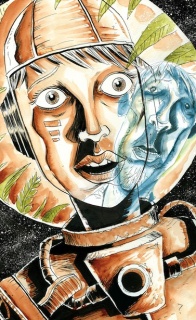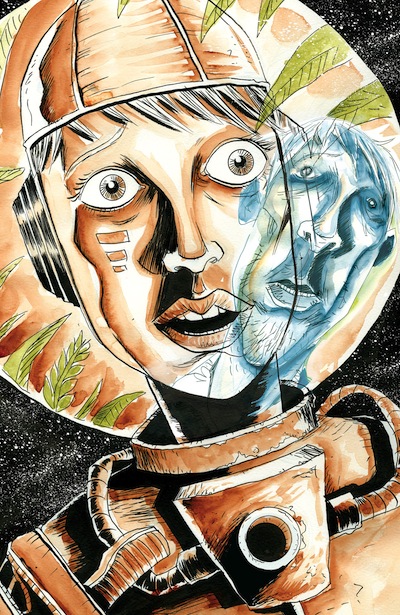Fans familiar with the typical simple beauty of a Jeff Lemire creator-owned project will find everything they love about it and more with “Trillium” #2.

Written and Illustrated by Jeff Lemire
Colors by Jose VillarrubiaIn the heart of the Amazon jungle, Nika, a scientist from the year 3797, and William, an explorer from 1921, struggle not only to survive but to make sense of the mind-bending events that have pulled them together across space and time. The mysteries continue to pile up as Vertigo’s new sci-fi epic launches into high gear!
Jeff Lemire, with Jeff Lemire’s own characters and Jeff Lemire’s own art in tow, is a master storyteller. There’s no two ways about it – the man produces beautiful and touching comics with one hell of a batting average. Or whatever the equivalent would be for hockey – sorry, Mr. Lemire, but I’m a football/baseball guy. And the key to a Jeff Lemire solo project is in how strangely emotionally engaging they are by being unrefined in all of the right ways. Don’t get me wrong, you would never mistake the dialogue and the art for being “bad” – not for one second. But the writing and the art is so simple and honest that it becomes gorgeous in its own aesthetic. True honesty in comic craft is beautiful. Whether its depicting events and characters from a hundred years ago, or showing us something from a thousand years in the future, “Trillium” is showing us something simple and honest. In this way, “Trillium” gets right to your heart.
They met at the center of the flipbook that was “Trillium” #1, but now Nika and William have to find a way to communicate – to connect, and cross differences that are the better part of two thousand years apart. Lemire does a beautiful trick in the balancing act of depicting two people who can’t understand each other’s spoken word. The results are sometimes played for comedy through juxtaposition, but we also get moments that endear us to both characters, inform us, and advance the plot itself. The reader is privy to what each character is saying, but the characters themselves must rely on the physicality of one another and the environmental context. Though the characters are trying to say some pretty complex things at times, Lemire is careful to include everything the characters would need from each other on the page. We can understand them, but we can also understand how they could slowly start to understand one another too. It’s carefully crafted stuff – almost like watching a really instinctive acting performance or an intricate stage play.
I already mentioned that this conversation endears us to the characters, but so too does it endear the characters to each other, in some ways. Though their goals are partially self-preservatory, there is already a sense of teamwork and the budding of something resembling fond feelings in the pairing. Where plenty of relationships in storytelling form out of writing tropes and cliches or convenience of storytelling, “Trillium” feels like something else. Yes, they’ve only known each other for an issue and a half. Yes, they can’t be sure how much they have in common. But regardless, the connection feels authentic – again, because of the simple beauty with which it’s depicted.
Jeff Lemire’s wobbly characters reflect humanity because even though they don’t appear to be realistic at all, they are free from the classic depictions of men and women in comics and something closer to authentic human beings that you would encounter on a daily basis. Nika is beautiful in the context of Lemire’s art, but she’s not va-va-voom. She’s not looking perfectly composed and made-up while out on a interdimensional expedition. She’s running around in a sweaty spacesuit and has no idea what to do about it. William is not some barrel-chested hunk. He’s kind of a scrawny, gangly dude – as the average Lemire dudes tend to be. They’re awkward with each other and trip over every misunderstanding, but they’re ultimately cool about it. They’re real people, while looking entirely cartoony, and all the more endearing for it.
Continued belowMost of the issue takes place in this intimate conversation, meaning that most of the issue’s power is in the body language of the characters, leaving little to speak of for much else in the way of visuals. The issue is going for “intimate” and staging and simple paneling are appropriate for such a comic. When Lemire does get an opportunity to cut loose with an interesting idea (look for a page where William and Nika gain some sort of “understanding” of one another), the art flexes more of its muscles and these sequences have a greater impact. Lemire’s design work shows itself and Jose Villarrubia’s colors come alive. Speaking of the color choices, the muted tans and greens of the Amazon jungle give way to tremendous watercolor backgrounds and the occasional opportunity to color weird alien stuff. This book doesn’t look like anything else on the stands (except for other Jeff Lemire books). Any fan of his should be tremendously happy with the visual feast that “Trillium’s” sci-fi setting and Villarrubia’s colors are giving us.
Easily a candidate for some end-of-the-year awards, but then again, isn’t that always the case when Jeff Lemire does his own thing? A more assured creator-owned creative talent you’d be hard-pressed to find. “Trillium” proves that Lemire has plenty of legs after the award-winning “Essex County” and “Sweet Tooth” have long been put away. There’s plenty of “Trillium” left, so if it wasn’t already on your radar by now, get it on there. And if Jeff Lemire isn’t yet someone you’re paying attention to, then what are you doing? Every creator-owned thing he does should be on automatic pull by now.
Final Verdict: 9.6 – Buy it. Love it.



